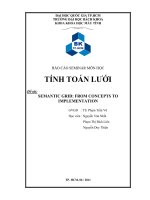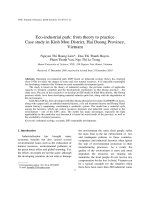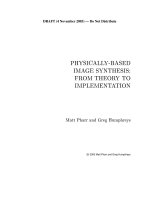Software quality assurance from theory to implementation
Bạn đang xem bản rút gọn của tài liệu. Xem và tải ngay bản đầy đủ của tài liệu tại đây (5.53 MB, 617 trang )
Galin_ppc
21/9/05
8:51 PM
Page 1
CYAN MAGENTA YELLOW BLACK
Software Quality Assurance
From theory to implementation
DANIEL GALIN
The book is a product of the author’s many years of consulting and teaching
experience.
Features:
✦ A broad view of SQA. Discussion goes beyond classic custom-made software to
include issues of in-house software development, outsourcing, and SQA in small
organizations.
✦ Comprehensive discussion of practical issues. Stress is placed throughout on
SQA application, operation, organization and control.
✦ Comprehensive coverage of SQA topics.Topics rarely covered in SQA texts are
included: procedures and work instructions, supportive quality devices, costs of
software quality and the actors participating in the SQA framework.
✦ State-of–the-art topics. Automated testing, computerized SQA tools and international standards (e.g., ISO 9000-3) are among the topics covered.
✦ Pedagogical support. Each chapter includes summary frames, case studies, real-life
examples and implementation tips, review questions and topics for discussion.
✦ On-line instructor’s guide.The guide contains lesson planning guidelines,
PowerPoint presentations and a test bank.
The book comprehensively covers the ISO 9000-3 requirements. It also provides a
substantial portion of the body of knowledge required for the CSQE (Certified
Software Quality Engineer) as outlined by the ASQ (American Society for Quality).
Dr Daniel Galin currently serves as Head of Information Systems Studies, the
Ruppin Academic Center. In addition to his many papers, Dr Galin has also authored
several books on the analysis and design of information systems as well as coauthoring (with Dr Z. Bluvband) a book on software quality assurance in Hebrew.
His professional experience includes numerous consulting projects in software quality
assurance and information systems design for major Israeli firms. He received his BSc,
MSc and DSc from the Faculty of Industrial and Management Engineering of the
Technion, Israel Institute of Technology, Haifa, Israel.
Cover image © Getty Images
www.pearson-books.com
Software Quality
Assurance
Software quality assurance (SQA) is becoming increasingly important to the software
and electronics industries as software systems become more complex and integrative.
This book is designed to serve the three audiences who will be facing the SQA
challenge: students at universities and colleges, participants in vocational training
courses and software development and maintenance practitioners/professionals.
Software
Quality
Assurance
From theory to implementation
DANIEL GALIN
GALIN
SQAS_A01.QXD
21/9/05
8:34 PM
Page i
Software Quality Assurance
SQAS_A01.QXD
21/9/05
8:34 PM
Page ii
We work with leading authors to develop the
strongest educational materials in computing,
bringing cutting-edge thinking and best
learning practice to a global market.
Under a range of well-known imprints, including
Addison Wesley, we craft high quality print and
electronic publications which help readers to understand
and apply their content, whether studying or at work.
To find out more about the complete range of our
publishing, please visit us on the World Wide Web at:
www.pearsoned.co.uk
SQAS_A01.QXD
21/9/05
8:34 PM
Page iii
Software Quality
Assurance
From theory to implementation
Daniel Galin
SQAS_A01.QXD
21/9/05
8:34 PM
Page iv
Pearson Education Limited
Edinburgh Gate
Harlow
Essex CM20 2JE
England
and Associated Companies around the world
Visit us on the World Wide Web at:
www.pearsoned.co.uk
First published 2004
© Pearson Education Limited 2004
The right of Daniel Galin to be identified as the
author of this work has been asserted by him in accordance
with the Copyright, Designs, and Patents Act 1988.
All rights reserved. No part of this publication may be reproduced, stored
in a retrieval system, or transmitted in any form or by any means, electronic,
mechanical, photocopying, recording, or otherwise without either the prior
written permission of the Publishers or a licence permitting restricted copying
in the United Kingdom issued by the Copyright Licensing Agency Ltd,
90 Tottenham Court Road, London W1T 4LP.
All trademarks used herein are the property of their respective owners. The use
of any trademark in this text does not vest in the author or publisher any
trademark ownership rights in such trademarks, nor does the use of such
trademarks imply any affiliation with or endorsement of this book by such owners.
ISBN 0201 70945 7
British Library Cataloguing-in-Publication Data
A catalogue record for this book is available from the British Library
Library of Congress Cataloging-in-Publication Data
Galin, Daniel,
Software quality assurance / Daniel Galin.
p. cm.
Includes bibliographical references and index.
ISBN 0-201-70945-7
1. Computer software--Quality control. I. Title.
QA76.76.Q35G35 2003
005.1'068'5--dc21
2003050668
10 9 8 7 6 5 4 3 2
09 08 07 06 05
Typeset in 10/12pt Sabon by 30.
Printed and bound in Great Britain by Biddles Ltd, Guildford and King’s Lynn
The publisher’s policy is to use paper manufactured from sustainable forests.
SQAS_A01.QXD
21/9/05
8:34 PM
Page v
To my parents,
Blima and Elchanan,
who inspired me with their love of learning,
scholarship, and teaching
SQAS_A01.QXD
21/9/05
8:34 PM
Page vi
SQAS_A01.QXD
21/9/05
8:34 PM
Page vii
Contents
Preface
Unique features of this text
The book’s audience
xvii
xviii
xix
Acknowledgements
xx
Publisher’s acknowledgements
xxi
About the author
xxii
Guides for special groups of readers
Guide to readers interested in ISO 9000-3 requirements
Guide to readers interested in ASQ’S CSQE body of knowledge
xxiii
xxiii
xxiv
Part I Introduction
Chapter 1 The software quality challenge
1.1
1.2
The uniqueness of software quality assurance
The environments for which SQA methods
are developed
Summary
Review questions
Topics for discussion
Chapter 2 What is software quality?
2.1
2.2
2.3
2.4
2.5
2.6
What is software?
Software errors, faults and failures
Classification of the causes of software errors
Software quality – definition
Software quality assurance – definition and objectives
Software quality assurance and software engineering
Summary
Selected bibliography
Review questions
Topics for discussion
1
3
4
7
11
12
12
14
15
16
19
24
25
30
30
32
32
33
SQAS_A01.QXD
viii
21/9/05
8:34 PM
Page viii
Chapter 3 Software quality factors
Contents
3.1
3.2
3.3
3.4
3.5
3.6
3.7
3.8
The need for comprehensive software quality
requirements
Classifications of software requirements into
software quality factors
Product operation software quality factors
Product revision software quality factors
Product transition software quality factors
Alternative models of software quality factors
Who is interested in the definition of quality
requirements?
Software compliance with quality factors
Summary
Selected bibliography
Review questions
Topics for discussion
Chapter 4 The components of the software quality
assurance system – overview
4.1
4.2
4.3
4.4
4.5
4.6
4.7
4.8
The SQA system – an SQA architecture
Pre-project components
Software project life cycle components
Infrastructure components for error prevention
and improvement
Management SQA components
SQA standards, system certification, and
assessment components
Organizing for SQA – the human components
Considerations guiding construction of an
organization’s SQA system
Part II Pre-project software quality components
Chapter 5 Contract review
5.1
5.2
5.3
5.4
5.5
5.6
Introduction: the CFV Project completion
celebration
The contract review process and its stages
Contract review objectives
Implementation of a contract review
Contract review subjects
Contract reviews for internal projects
35
36
37
38
41
43
44
47
49
51
52
52
54
56
57
60
61
65
68
69
70
72
75
77
78
79
80
82
85
85
SQAS_A01.QXD
21/9/05
8:34 PM
Page ix
87
88
89
89
Chapter 6 Development and quality plans
95
6.1
6.2
6.3
6.4
Development plan and quality plan objectives
Elements of the development plan
Elements of the quality plan
Development and quality plans for small projects
and for internal projects
Summary
Selected bibliography
Review questions
Topics for discussion
Appendix 6A: Software development risks and
software risk management
92
94
97
97
101
103
106
108
109
110
112
Part III SQA components in the project life cycle 119
Chapter 7 Integrating quality activities in the
project life cycle
7.1
7.2
7.3
7.4
Classic and other software development
methodologies
Factors affecting intensity of quality assurance
activities in the development process
Verification, validation and qualification
A model for SQA defect removal effectiveness
and cost
Summary
Selected bibliography
Review questions
Topics for discussion
Chapter 8 Reviews
8.1
8.2
Review objectives
Formal design reviews (DRs)
121
122
131
133
135
143
145
146
147
149
150
152
ix
Contents
Summary
Selected bibliography
Review questions
Topics for discussion
Appendix 5A: Proposal draft reviews –
subjects checklist
Appendix 5B: Contract draft review –
subjects checklist
SQAS_A01.QXD
x
21/9/05
8:34 PM
Contents
8.3
8.4
8.5
Page x
Peer reviews
A comparison of the team review methods
Expert opinions
Summary
Selected bibliography
Review questions
Topics for discussion
Appendix 8A: DR report form
Appendix 8B: Inspection session findings report form
Appendix 8C: Inspection session summary report
Chapter 9 Software testing – strategies
9.1
9.2
9.3
9.4
9.5
158
168
170
171
172
172
174
175
176
177
178
Definition and objectives
Software testing strategies
Software test classifications
White box testing
Black box testing
Summary
Selected bibliography
Review questions
Topics for discussion
180
182
187
189
197
209
211
212
213
Chapter 10 Software testing – implementation
216
10.1
10.2
10.3
10.4
The testing process
Test case design
Automated testing
Alpha and beta site testing programs
Summary
Selected bibliography
Review questions
Topics for discussion
Chapter 11 Assuring the quality of software
maintenance components
11.1
11.2
11.3
11.4
Introduction
The foundations of high quality
Pre-maintenance software quality components
Maintenance software quality assurance tools
Summary
Selected bibliography
Review questions
Topics for discussion
217
232
235
245
247
249
250
251
254
255
257
261
264
273
275
275
277
SQAS_A01.QXD
21/9/05
8:34 PM
Page xi
Chapter 12 Assuring the quality of external
participants’ contributions
12.4
12.5
Introduction: the HealthSoft case
Types of external participants
Risks and benefits of introducing external
participants
Assuring quality of external participants’
contributions: objectives
SQA tools for assuring the quality of external
participants’ contributions
Summary
Selected bibliography
Review questions
Topics for discussion
Chapter 13 CASE tools and their effect on software
quality
13.1
13.2
13.3
13.4
280
282
283
286
287
293
295
295
296
298
What is a CASE tool?
299
The contribution of CASE tools to software
product quality
302
The contribution of CASE tools to software
maintenance quality
304
The contribution of CASE tools to improved project
management
304
Summary
305
Selected bibliography
306
Review questions
306
Topics for discussion
307
Part IV Software quality infrastructure
components
309
Chapter 14 Procedures and work instructions
311
14.1
14.2
14.3
14.4
The need for procedures and work instructions
Procedures and procedures manuals
Work instructions and work instruction manuals
Procedures and work instructions: preparation,
implementation and updating
Summary
Selected bibliography
Review questions
Topics for discussion
Appendix 14A: Design review procedure
312
313
316
317
318
319
319
320
322
Contents
12.1
12.2
12.3
xi
279
SQAS_A01.QXD
xii
21/9/05
8:34 PM
Page xii
Chapter 15 Supporting quality devices
Contents
15.1
15.2
325
Templates
Checklists
Summary
Selected bibliography
Review questions
Topics for discussion
326
329
332
333
333
334
Chapter 16 Staff training and certification
335
16.1
16.2
16.3
16.4
16.5
16.6
16.7
16.8
16.9
16.10
Introduction: Surprises for the “3S”
development team
The objectives of training and certification
The training and certification process
Determining professional knowledge requirements
Determining training and updating needs
Planning training and updating programs
Defining positions requiring certification
Planning the certification processes
Delivery of training and certification programs
Follow-up subsequent to training and certification
Summary
Selected bibliography
Review questions
Topics for discussion
Chapter 17 Corrective and preventive actions
17.1
17.2
17.3
17.4
17.5
17.6
17.7
17.8
Introduction: the “3S” development team revisited
Corrective and preventive actions – definitions
The corrective and preventive actions process
Information collection
Analysis of collected information
Development of solutions and their implementation
Follow-up of activities
Organizing for preventive and corrective actions
Summary
Selected bibliography
Review questions
Topics for discussion
336
337
338
338
339
340
340
341
342
344
345
346
347
347
349
350
351
352
353
354
356
359
360
361
362
362
363
SQAS_A01.QXD
21/9/05
8:34 PM
Page xiii
18.1
18.2
18.3
18.4
18.5
18.6
18.7
Software configuration, its items and its management
Software configuration management – tasks and
organization
Software change control
Release of software configuration versions
Provision of SCM information services
Software configuration management audits
Computerized tools for managing software
configuration
Summary
Selected bibliography
Review questions
Topics for discussion
Chapter 19 Documentation control
19.1
19.2
19.3
19.4
19.5
19.6
Introduction: where is the documentation?
Controlled documents and quality records
The controlled documents list
Controlled document preparation
Issues of controlled document approval
Issues of controlled document storage and retrieval
Summary
Selected bibliography
Review questions
Topics for discussion
Part V Management components of software
quality
Chapter 20 Project progress control
20.1
20.2
20.3
20.4
The components of project progress control
Progress control of internal projects and external
participants.
Implementation of project progress control regimes
Computerized tools for software progress control
Summary
Selected bibliography
Review questions
Topic for discussion
365
xiii
367
Contents
Chapter 18 Configuration management
369
371
373
380
380
381
382
383
384
384
387
388
389
392
393
393
394
395
396
397
397
399
401
402
404
405
406
408
409
410
411
SQAS_A01.QXD
xiv
21/9/05
8:34 PM
Page xiv
Chapter 21 Software quality metrics
Contents
21.1
21.2
21.3
21.4
21.5
21.6
Objectives of quality measurement
Classification of software quality metrics
Process metrics
Product metrics
Implementation of software quality metrics
Limitations of software metrics
Summary
Selected bibliography
Review questions
Topics for discussion
Appendix 21A: The function point method
Chapter 22 Costs of software quality
22.1
22.2
22.3
22.4
22.5
Objectives of cost of software quality metrics
The classic model of cost of software quality
An extended model for cost of software quality
Application of a cost of software quality system
Problems in the application of cost of software
quality metrics
Summary
Selected bibliography
Review questions
Topics for discussion
412
414
415
416
420
427
432
434
436
438
440
442
449
450
451
455
458
462
463
465
465
468
Part VI Standards, certification and assessment 471
Chapter 23 Quality management standards
23.1
23.2
23.3
23.4
23.5
23.6
The scope of quality management standards
ISO 9001 and ISO 9000-3
Certification according to ISO 9000-3
Capability Maturity Models – CMM and CMMI
assessment methodology
The Bootstrap methodology
The SPICE project and the ISO/IEC 15504
software process assessment standard
Summary
Selected bibliography
Review questions
Topics for discussion
Appendix 23A: CMMI process areas
Appendix 23B: ISO/IEC 15504 model processes
475
476
477
481
485
490
492
497
499
500
501
502
505
SQAS_A01.QXD
21/9/05
8:34 PM
Page xv
Chapter 24 SQA project process standards –
IEEE software engineering standards
24.2
24.3
24.4
Structure and content of IEEE software engineering
standards
IEEE/EIA Std 12207 – software life cycle processes
IEEE Std 1012 – verification and validation
IEEE Std 1028 – reviews
Summary
Selected bibliography
Review questions
Topics for discussion
Appendix 24A: IEEE Software Engineering Standards
Appendix 24B: MIL-STD-498: list of Data Item
Descriptions (DIDs)
Appendix 24C: Task structure for a primary process
according to IEEE/EIA Std 12207 – example
509
510
514
519
521
524
524
525
526
528
528
Part VII Organizing for quality assurance
539
Chapter 25 Management and its role in software
quality assurance
543
25.1
25.2
25.3
Top management’s quality assurance activities
Department management responsibilities for quality
assurance
Project management responsibilities for quality
assurance
Summary
Selected bibliography
Review questions
Topics for discussion
544
549
550
551
552
553
554
Chapter 26 The SQA unit and other actors in the SQA
system
555
26.1
26.2
26.3
26.4
The SQA unit
SQA trustees and their tasks
SQA committees and their tasks
SQA forums – tasks and methods of operation
Summary
Review questions
Topics for discussion
556
563
563
564
565
568
568
Contents
24.1
xv
507
SQAS_A01.QXD
xvi
21/9/05
8:34 PM
Page xvi
Epilogue The future of SQA
570
Contents
Facing the future: SQA challenges
Facing the future: SQA capabilities
571
574
Author index
577
Subject index
580
SQAS_A01.QXD
21/9/05
8:34 PM
Page xvii
Preface
The opening of the new Denver International Airport (DIA) in February
1995 was a day of celebration for Colorado citizens but it was certainly the
end of a traumatic period for the information technology industry. DIA was
planned to be the largest airport in the United States, to serve 110 000 000
passengers annually by 2020, to handle 1750 flights daily through 200 gates
and 12 operating runways. Operations at DIA were delayed by 16 months,
mainly due to the failure of the software-based baggage handling system,
causing estimated total losses of $2 billion. Moreover, the baggage handling
system finally put into service was substantially downscaled in comparison
to the system originally specified. Although several other colossal failures of
software systems unfortunately have been recorded since 1995, the failure of
IT technology at DIA was especially traumatic to the profession, whether
due to the scale of the losses or the public interest and criticism it raised.
Many SQA professionals, including the author, believe that had appropriate software quality assurance systems been applied to the project at its
start, a failure of this scale would not have occurred or, at least, its losses
would have been dramatically reduced. The methods and tools discussed in
this book, especially the risk management procedures, could have identified
the severity of the situation at very early stages and enabled timely employment of the appropriate corrective measures throughout the project. Other
SQA tools could probably have assured completion of the system on schedule
and in full compliance with its specifications.
According to the author’s conception of software quality assurance, an
acceptable level of software quality can be achieved by:
■
■
■
■
Combined application of a great variety of SQA components.
Special emphasis on quality in the early phases of software development,
including the pre-project phase.
Performance of comprehensive SQA activities to control the quality of the
work carried out by external participants (subcontractors, suppliers of
reused software modules and COTS software products, and the customers themselves in cases where they carry out parts of the project).
Extension of SQA activities to project schedules and budget control,
based on the expectation that functional requirements, schedule and
budget plans behave according to the principle of communicating vessels,
that is, a failure (or reduced level of achievement) in one of these three
fluid components induces immediate failure in the others.
This conception of software quality assurance guides us throughout the book.
SQAS_A01.QXD
xviii
21/9/05
8:34 PM
Page xviii
Unique features of this text
Preface
The following features of this book are of special importance:
■
■
■
■
A broad view of SQA
Comprehensive discussion of SQA implementation issues
Comprehensive coverage of SQA topics
State-of-the-art topics.
A detailed discussion of these features follows.
A broad view of SQA
The book extends discussion of SQA issues much beyond the classic boundaries of custom-made software development by large established software
houses. It dedicates significant attention to the other software development
and maintenance environments that reflect the current state of the industry:
■
■
■
In-house software development by information systems departments. The
book discusses SQA of in-house projects, situations where traditional
customer–supplier relations are missing or vague, and outlines recommended solutions to the attendant risks (see Sections 5.6 and 6.4.2).
COTS software packages. COTS software packages represent a growing
proportion of software packages used throughout the industry. Assurance
of the quality of these packages, which are integrated directly into the customer’s software systems, has become an important issue (see Chapter 12).
Small projects and small organizations. Issues related to software development by small organizations and the execution of small software
projects are likewise dealt with in the book (see Section 6.4.1).
Comprehensive discussion of SQA implementation issues
Stress is placed throughout the book on organization, control and other
aspects arising in the implementation of SQA components:
■
■
■
■
Specialized chapter sections and subsections dealing with implementation
processes.
Examples that refer to real-life situations, especially those involving
implementation issues, are integrated into the text.
Implementation tips related to special implementation problems are integrated into most of the chapters.
Topics for discussion, found at the conclusion of each chapter, encourage
the reader to suggest innovative solutions to implementation issues.
Comprehensive coverage of SQA topics
The book is very comprehensive in the range of SQA subjects covered. It
includes topics rarely if ever covered in other SQA texts. These topics include:
SQAS_A01.QXD
■
■
■
8:34 PM
Page xix
Procedures and work instructions, their preparation, implementation and
updating (Chapter14).
Supporting quality devices, that is, templates and checklists, their preparation, implementation and updating (Chapter 15).
Costs of software quality, estimated according to the classic quality costs
model in addition to a new extended model that better represents the special nature of software quality costs (Chapter 22).
The SQA unit and other actors in the SQA framework, specifically the
activities and responsibilities of active and occasional bodies that promote SQA issues within the organization: the SQA unit, SQA trustees,
SQA committees and SQA forums (Chapter 26).
State-of–the-art topics
The text emphasizes up-to-date SQA topics:
■
■
■
Automated testing, including a discussion of the various types of automated tests and their implementation, concluding with a review of the
advantages and disadvantages of automated testing (Section 10.3).
Computerized SQA tools, discussed in conjunction with almost all SQA
components mentioned in the book. A special chapter (Chapter 13),
entirely dedicated to computerized tools, reviews CASE tool issues.
Special emphasis is placed on techniques that dramatically improve the
performance of SQA tools, such as automated testing, software configuration management and documentation control.
International SQA standards. Two chapters (Chapters 23 and 24) are
dedicated to a survey of recent developments in software quality management standards and project process standards.
A downloadable Instructor’s Guide, PowerPoint Slides and additional testing material are also available free of charge to lecturers and tutors adopting
the main book. They can be accessed at www.booksites.net/galin.
The book’s audience
The book is intended to meet the needs of a wide audience of readers interested in software quality assurance. We can identify four main groups of
such readers, as follows:
■
■
■
■
Managers of software development departments, project managers
and others
Those attending or presenting vocational training courses
University and college students
Practitioners involved in quality issues of software development and
maintenance.
In addition, there are special groups of readers who are addressed on page
xxiii.
xix
Preface
■
21/9/05
SQAS_A01.QXD
21/9/05
8:34 PM
Page xx
Acknowledgements
This book has benefited from comments by software consumers as well as
questions from students in the many courses I have taught at the Technion,
Israel Institute of Technology, the Ruppin Academic Center and elsewhere.
They helped me improve my explanations and inspired many of my examples. Others helped by directly answering questions or supplying valuable
articles, books and other material. Their numbers prevent my mentioning all
their names. I am grateful to each.
Special thanks to Andrea Shustarich, representative of Pearson
Education in Israel, who encouraged me to write this book and followed its
progress. My editor, Keith Mansfield, a senior acquisition editor at Pearson
Education in the UK, also deserves special recognition for his cooperation,
continuous guidance and valuable advice throughout the long months of
writing. I would especially like to express my appreciation to Nicola
Chilvers, responsible for production of this book at Pearson Education,
whose efficiency and amiable manner made working together such pleasure.
In addition, I wish to express my appreciation to Nina Reshef, who edited
my drafts with devotion and contributed substantially to the book’s readability and accuracy.
Finally, I wish to say how grateful I am to my family, my wife Amira
Galin, my daughter Michal Nisanson and my son Yoav Galin for their continuous support and encouragement as well as for their important comments
on the book’s drafts.
SQAS_A01.QXD
21/9/05
8:34 PM
Page xxi
Publisher’s acknowledgements
We are grateful to the following for permission to reproduce copyright material:
Figure 7.1 adapted from Royce, W.W. (1970) Managing the Development of
large Software Systems: Concepts and Techniques, Proceedings of the IEEE
WESCON, August 1970 and Software Engineering Economics by Boehm,
B.W. © 1981. Reprinted by permission of Pearson Education, Inc., Upper
Saddle River, NJ. Figure 7.3 adapted from Boehm, B.W. (1988) A Spiral
Model of Software Development and Enhancement, Computer, Vol. 21, No.
5, pp. 61–72; Figure 7.4 adapted from Boehm, B.W. (1998) Using the WinWin Spiral Model: A case study, Computer, Vol. 31, No. 7, pp. 33–44; Table
8.3 and Table 21.11 from Japan’s Software Factories: A Challenge to U.S.
Management by Michael A. Cusumano, copyright 1991 by Oxford
University Press, Inc. Used by permission of Oxford University Press, Inc.;
Table 10.6 adapted from Dustin/Rashka/Paul, Automated Software Testing:
Introduction, Management and Performance, Table 2.4 (p. 53), © Pearson
Education, Inc. Reprinted by permission of Pearson Education, Inc.; Table
23.1 and Table 23.2 reproduced with the permission of BSI under licence no.
2003SK/0025. British Standards can be obtained from BSI Customer
Services, 389 Chiswick High Road, London W4 4AL (Tel. +44 (0) 208 996
9001). Figure 23.2 Capacity Maturity Model by Paulk et al. © Reprinted by
permission of Pearson Education, Inc., Upper Saddle River, NJ. Table 23.5
and 23.6 adapted from Jung, H.-W., Hunter, R., Goldenson, D.R. and ElEman, K. (2001) Finding the Phase 2 of the SPICE Trials, Software Process
Improvement and Practice, 7(6) pp. 205–42. © John Wiley & Sons Limited.
Reproduced with permission. Figure 24.1 reprinted with permission from
IEE Std 1045-19992 by IEEE. The IEEE disclaims any responsibility or liability resulting from the placement and use in the described manner.
BSI for the eight principles of ISO 9000.3 and the structure of the ISO/IEC
TR 15504 Standard (under licence number 2003DH0143), and IEEE for
IEEE Std. 10278 (reviews) © 1994 IEEE and list of IEEE Software
Engineering Standards.
In some instances we have been unable to trace the owners of copyright
material, and we would appreciate any information that would enable us to
do so.
SQAS_A01.QXD
21/9/05
8:34 PM
Page xxii
About the author
Dr Daniel Galin received his B.Sc. in Industrial and Management
Engineering, and his M.Sc. and D.Sc. in Operations Research from the
Faculty of Industrial and Management Engineering, the Technion, Israel
Institute of Technology, Haifa, Israel. He serves on the faculty of the Ruppin
Academic Center, where he is the current Head of Information Systems
Studies.
Dr Galin acquired his expertise in SQA through teaching, writing and
consulting in the field. He teaches courses in software quality assurance and
information systems at the Ruppin Academic Center, Information Systems
Studies, at the Faculty of Computer Sciences, the Technion, Haifa and at the
College of Administration, Tel-Aviv.
Dr Galin co-authored (with Dr Z. Bluvband) the book Software Quality
Assurance. His many papers have been published in professional journals,
the majority in English-language journals. All his former books on analysis
and design of information systems and software quality assurance were written
in Hebrew and published by Israel’s leading publishers.
Dr Galin’s professional experience of over 20 years includes consulting
on numerous projects in software quality assurance as well as analysis and
design of information systems.
SQAS_A01.QXD
21/9/05
8:34 PM
Page xxiii
Guides for special groups
of readers
Among the readers interested in software quality assurance, one can distinguish two special groups:
■
■
Readers interested in ISO 9000-3 requirements
Readers interested in the American Society for Quality’s (ASQ) CSQE
(Certified Software Quality Engineer) body of knowledge.
The following tables direct the reader to the chapters and sections relevant
to their interests.
Guide to readers interested in ISO 9000-3 requirements
The reader interested in ISO 9000-3 requirements will find a comprehensive
discussion of standard ISO issues in Chapter 23. In addition, related material is spread throughout the book, as detailed in the following table. The ISO
9000-3 requirements numbers quoted are taken from the outline of ISO/IEC
9000-3:2001 (final draft).
ISO 9000-3
requirements:
chapter
ISO 9000-3 requirements:
subject
Book references
(chapter/section)
4. Quality
management
system
4.1 General requirements
4.2 Documentation requirements
Ch. 4
Ch. 19
5. Management
responsibilities
5.1 Management commitments
5.2 Customer focus
5.3 Quality policy
5.4 Planning
5.5 Responsibility authority and communication
5.6 Management review
Sec. 25.1
Sec. 25.1.1
Sec. 25.1.1
Ch. 25
Ch. 25
Sec. 25.1.3
6. Resource
management
6.1 Provision of resources
6.2 Human resources
6.3 Infrastructure
Sec. 25.1.1
Ch. 16
Secs 10.3, 11.4,
Chs 13, 14, 15,
Secs 18.7, 19.5, 20.4
Sec. 1.2
6.4 Work environment
SQAS_A01.QXD
xxiv
21/9/05
8:34 PM
Guides for special groups of readers
ISO 9000-3
requirements:
chapter
Page xxiv
ISO 9000-3 requirements:
subject
7. Product realization 7.1 Planning of product realization
7.2 Customer-related processes
7.3 Design and development
7.4 Purchasing
7.5 Production and service provision
7.6 Control of monitoring and measuring devices
8. Measurement,
analysis and
improvement
8.1 General
8.2 Monitoring and measurement
8.3 Control of non-conforming product
8.4 Analysis of data
8.5 Improvement
Book references
(chapter/section)
Chs 6, 23, 24
Chs 3, 5, 6, 12, 20
Chs 7, 8, 9, 10,
Sec. 18.3
Ch. 12
Chs 11, 12,
Secs 18.4–18.6,
Ch. 20
Sec. 18.1
Secs 21.1, 21.2,
22.1–22.3
Secs 21.3, 21.4,
22.4, 22.5
Secs 21.5, 22.4,
22.5, 26.1
Sec. 17.6
Ch. 17
Guide to readers interested in ASQ’s CSQE body of knowledge
Almost all the elements of the CSQE (Certified Software Quality Engineer)
body of knowledge, as outlined in ASQ (American Society for Quality) Item
B0110, are included in the book. The following table directs the reader to
the relevant chapters and sections.
CSQE body of
knowledge:
chapter
CSQE body of knowledge:
subject
Book references
(chapter/section)
I. General
knowledge, conduct,
and ethics
A. Standards
B. Quality philosophy and principles
C. Organizational and interpersonal techniques
D. Problem-solving tools and processes
Sec. 2.1, Ch. 23
Secs 2.4, 2.5
Ch. 25
Secs 6.2, 6.3,
App. 6A
–
E. Professional conduct and ethics
II. Software quality
management
A. Planning
B. Tracking
C. Organizational and professional software
quality training
III. Software processes A. Development and maintenance methods
B. Process and technology change management
Ch. 6, Secs 7.4,
17.2, 17.3
Ch. 6,
Secs 17.4–17.8,
Ch. 18
Sec. 11.4, Ch. 16
Sec. 7.1,
Chs 8, 11, 13, 19
Secs 18.3–18.7,
Ch. 25









